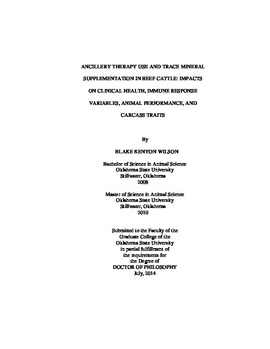| dc.description.abstract | Newly received calves that received antimicrobial treatment for bovine respiratory disease (BRD) were randomly assigned to 1 of 4 experimental ancillary therapy (ANC) groups: flunixin meglumine (NSAID), viral vaccination (VACC), vitamin C (VITC), or no ANC (NOAC). When contrasted with the average of NSAID, VACC, and VITC calves receiving NOAC tended to have heavier BW on d 56, greater ADG and DMI from first BRD treatment through d 28, greater DMI from d 28 through d 56, and had greater DMI from first BRD treatment through d 56 with mortalities and removals excluded (P = 0.06, P = 0.10, P = 0.08, P = 0.06, and P = 0.05 respectively). Overall morbidity and mortality attributed to BRD were 66.5% and 13.2% respectively. After the receiving period, calves were grouped by previous ANC treatment and the number of times treated for BRD (BRDX) and allocated to finishing pens. The BRDX experimental groups included: never treated for BRD (0X), treated 1 time (1X), 2 times (2X), or 3 or 4 times (3/4X). Ultrasound estimates, BW, and visual appraisal were used to target a common compositional end point for each pen of cattle. No ANC group differences existed for any of variables analyzed (P P ≥ 0.26). With increasing BRDX, days on feed and lung consolidation scores increased linearly (P ≤ 0.01), while hot carcass weight, dressing percentage, ribeye area, and the percentage of USDA Prime and Choice carcasses decreased linearly (P ≤ 0.03). An additional experiment examined the effects of copper (Cu), manganese (Mn), and zinc (Zn) supplementation on the clinical signs, immune response variables, and mineral status of calves following a bovine viral diarrhea virus (BVDV) and Mannheimia haemolytica (MH) immune challenge. Steers were randomly pairwise assigned to either a mineral supplemented (MIN) or control (CON) experimental treatments. There was a significant (P < 0.0001) time by treatment interaction observed for liver Cu levels. Time significantly impacted the concentrations of Cu, Mn, Fe, and Zn within the liver, Cu, Mn, and Zn within the muscle, and Cu, Fe, and Zn within the serum (P ≤ 0.05). Calves receiving MIN had greater liver Cu (P = 0.0001) and Mn (P = 0.0075) concentrations compared to CON calves. In contrast, serum Cu and Fe concentrations were increased (P ≤ 0.05) in CON calves compared to MIN calves. The use of ANC does not appear to positively impact clinical health and could potentially be detrimental to receiving performance in severely immune challenged calves. Calves treated multiple times for BRD are able to reach similar compositional end points as untreated cohorts; however, it may not be possible for treated calves to achieve similar carcass traits. The supplementation of Cu, Mn, and Zn may impact the antibody response to a BVDV and MH immune challenge in calves. When Cu is supplemented to calves receiving a marginally Cu deficient diet, Cu status within the body can be altered. | |
